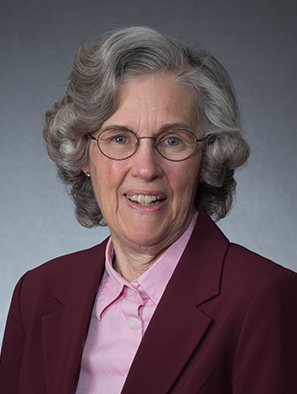
Sandra Eaton
Professor
303-871-3102 (Office)
Seeley G. Mudd Building, 2101 E. Wesley Ave. Denver, CO 80208
What I do
My teaching is primarily in undergraduate and graduate physical chemistry. I run a joint research group with Professor Gareth Eaton. We are involved in multiple collaborative research project including EPR instrument development and application to biochemical problems. I am also the Chair of the Department of Chemistry and BiochemistrySpecialization(s)
electron paramagnetic resonance
Professional Biography
Education
B.A. (Chemistry), Wellesley College, Wellesley, MA 1968
Ph.D (Inorganic Chemistry), Massachusetts Institute of Technology, 1972
Asst. Prof, University of Colorado Denver, 1973 - 1979
Assoc. Prof, University of Colorado Denver, 1979 - 1986
Professor, University of Colorado Denver, 1986 - 1989
Professor, University of Denver, 1989 - present
B.A. (Chemistry), Wellesley College, Wellesley, MA 1968
Ph.D (Inorganic Chemistry), Massachusetts Institute of Technology, 1972
Asst. Prof, University of Colorado Denver, 1973 - 1979
Assoc. Prof, University of Colorado Denver, 1979 - 1986
Professor, University of Colorado Denver, 1986 - 1989
Professor, University of Denver, 1989 - present
Degree(s)
- Ph.D., Inorganic Chemistry, Massachusetts Institute of Technology, 1972
- BA, Chemistry, Wellesy College, 1968
Professional Affiliations
- American Chemical Society
- International EPR Society
- Phi Beta Kappa
Research
The Eaton group develops new electron paramagnetic resonance (EPR) methods and instrumentation to address significant biochemical and chemical problems. A major current emphasis is on EPR methods to improve sensitivity and solve biomedical problems. In collaboration with research groups at the University of Chicago and University of Maryland we are developing methods for imaging local oxygen in vivo and methods for in vivo study of the physiology of tumors. Our team includes chemists, biochemists, physicists, and engineers. Our instrumentation includes state of the art Bruker BioSpin and locally-constructed spectrometers. Dissemination to the research community, in addition to over 350 research papers and reviews, includes a book on EPR imaging, a book on quantitative EPR, and major book chapters about electron spin relaxation and rapid scan EPR.
Areas of Research
electron paramagnetic resonance
distances between sites in biomolecules
electron spin relaxation times
Key Projects
- Development of an X-Band Rapid Scan EPR Spectrometer
- New Nitroxide Spin Labels for Distance Measurements in Biological Systems
- QLC: EAGER: Toward Magnetic Selectivity with Molecular Clock Qubits
Featured Publications
. (2010). Quantitative EPR. New York: Springer-Verlag/Wein.
. (2018). Relaxation mechanisms. In D. Goldfarb & S. Stoll (Eds.), EPR spectroscopy: Fundamentals and methods (pp. 175-192). John Wiley and Sons.
Presentations
. (2017). Rapid-scan EPR Imaging. 50th Annual Meeting. Oxford, England: Electron Spin Resonance Group of the Royal Society of Chemistry.
. (2017). Digital Saturation Recovery with an Arbitrary Waveform Generator Source. EPR Present and Future. New Paltz NY: Joint SPP1601/Shared EPR Group.
. (2017). Electron Spin Relaxation of Nitroxides Designed for DEER Experiments. EPR-2017. Morgantown WV.
. (2018). Field-Reversal Method for Rapid Scan Background Correction. 59th Rocky Mountain Conference on Magnetic Resonance. Snowbird, Utah: Rocky Mountain Conference on Analytical Chemistry.
. (2018). Electron Spin Relaxation Times of Spin-Labels without Gem-dimethyl Groups. 59th Rocky Mountain Conference on Magnetic Resonance. Snowbird, Utah: Rocky Mountain Conference on Analytical Chemistry.
Awards
- John Evans Professorship, University of Denver
- Bruker Prize, Royal Society of London, EPR Discussion Group
- Colorado Section Award, American Chemical Society, Colorado Section


